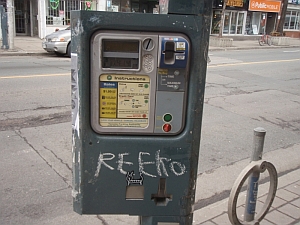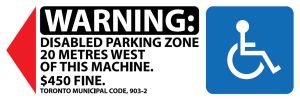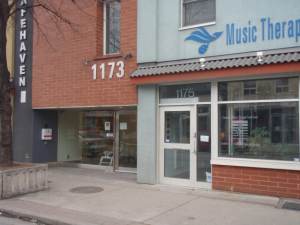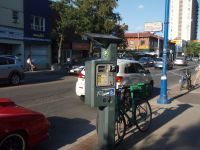Controls: show
 Document
Document
 Comments:
Comments:
[log in] or [register] to leave a comment for this document.
Go to:  all documents
all documents
Options: show
Path:
Looking inside:
 Disabled parking/loading signage: The problem
Disabled parking/loading signage: The problem
( display item 5)
display item 5)
Contact:
Website:
[home] [about] [help] [policies] [legal disclaimer]
Subsites:
 documents
documents topics
(or
topics
(or  site menu)
site menu)
 blogs
(or
blogs
(or  posts)
posts) library resources
(including
library resources
(including  pictures)
pictures) database (all)
database (all)
Members:
 return to container details page
return to container details page

 previous display previous display |
next display

|
 Document
Document
 ·5·
Summary of correspondances
·5·
Summary of correspondances
Disabled parking/loading signage 22-Sep-2014 [9600]
On October 28, 2010, David Cayley loaded his crippled bike into the trunk of his car to take it to the bike repair place. He parked across the street from the bike store and paid for parking at the pay-and-display machine, put the receipt on the dash, and took his bike inside.
When he came back out less than ten minutes later, he found a ticket on the windshield. It said he had illegally parked in a disabled parking space and would be fined $450. He had noticed the pay-and-display machine but not the "disabled parking" signs. The signage was in front of a storefont called "Safehaven" and another one called "Music Therapy Centre." The "Music Therapy" Storefront had a waiting room with chairs, the "Safehaven" one had some flowers and a teddy bear sitting in a rocking chair, and a curved staircase. Neither of the storefronts gave any visual cue that they were for disabled people. The signs were there, though, along with the usual glut of other municipal and commercial signs that are normally found on major arterial roads with storefronts.
There was a tree right next to one of the disabled parking signs, which partially obstructed the sign if a person was standing on the other side of the tree.
David called 311 to ask who to contact about getting better signage at that spot. He was told “contact parking tags,” but they just said, go to court. Tell it to the judge. So he filed the ticket and waited for his court date notification. The backlog in traffic court is so long that the the court date was scheduled for May 23 2012, one and a half years after the ticket was issued.
David's wife Jutta encouraged him to keep trying a bit longer. So on January 21 2011, David wrote a letter to Ward 18 Councillor Ana Bailao, asking for road markings to make the disabled parking zone more obvious.
There was no reply, so on May 17, 2011, David sent his letter again. On May 20, 2011, councillor assistant Michael Vieira wrote to Jeremy Gowling of Transportation Services about markings. It didn't take Mr.Gowling long to consider the request: two hours later, he wrote back: “the disabled loading zone is clearly visible....the signs were installed March 10, 2008. As we do not install pavement markings to supplement on-street accessible loading zones, no further action will be taken.”
The response seemed a bit hasty, and more research seemed warranted. On May 26, 2011, David asked the councillor's office if they could find out how many tickets are given out at that spot, what the city's signage rules are, and where the fine revenue goes.
Mr. Gowling of Transportation Services wrote: “Any information related to the number of tickets issued will have to be requested from the Toronto Police Service.” The parking fine revenue, he wrote, goes straight into the City's general funds. And he attached two excerpts from the Ontario Traffic Manual, which say that pavement markings are permitted but optional.
On September 13, 2011, the councillor's office contacted the Toronto Police Service, to find out about the number of tickets issued. The Parking Enforcement Supervisor advised the councillor to check with Parking Tag Operations, whose representative (Anthony Fabrizi) said: “We don't have the ability to provide accurate information on a specific location.”
On September 18, 2011, David again asked Councillor Ana Bailao if she could ask for pavement markings at the address being discussed. David also put in a Freedom of Information request to Toronto Police Service, asking how many tickets had been given for the disabled parking location at that one address, for the previous three calendar years.
Two weeks later, the Freedom of Information office of the Toronto Police Service wrote to say that parking fines are not a police matter, and that they had therefore rerouted the request to the City of Toronto Corporate Access and Privacy Office
On September 26, 2011, Ward 18 Councillor Ana Bailao wrote to Andy Koropeski, Acting General Manager of the Transportation Services Division, asking for pavement markings.
On Nov.7, 2011, David received the Freedom of Information notice. We wrote to the councillor to let her know that the parking fines at that one location were $155,000 over three years (FOI). We asked if there had been any response to her letter from Transportation Services (no). So we asked her to try again: could the city do a test on this space with pavement markings? (Yellow on the curb and a sign on pavement). Once the clear disabled parking markings went in, it would be easy to see if the tickets at that location went down.
On Nov.8 2011, David got a letter from Court Services, setting the court date for the ticket: May 23 2012.
On Nov.16, 2011, David submitted a Freedom of Information request asking how many disabled parking spaces there are on Toronto's arterial roads. He also asked for the total amount of disabled parking fines, citywide, for the same three year-period as before: 2008, 2009, and 2010.
On Nov.28, 2011, the councillor's assistant called to say that Ward 18 Councillor Ana Bailao had met with Andy Koropeski, acting general manager of the Transportation Services Division, and had requested pavement markings. (This was one item in the agenda of a multi-purpose meeting.) Mr.Koropeski apparently told her he’d consider it.
On Dec. 15 2011: David received word from Freedom of Information, saying that the City of Toronto had obtained a total of $3,964,686.42 in disabled parking fines in 2008, 2009, and 2010.
Since there was no follow-up on this, on January 13, 2012, Jutta wrote to Kevin Connor of the Toronto Sun. He had just written an article about a man who was visiting from Edmonton, and who got a $450 ticket for not noticing the disabled parking sign outside the hospital where he was visiting his father. Mr. Connor said the Sun would possibly do an article on the windfall the city gets from its disabled parking spaces.

On February 7, 2012 Jutta wrote an e-mail to Councillor Ana Bailao: “If there's no word by the end of this week, it may be time to go to the ombudsman, what do you think? Or should David first write a registered letter to Transportation, repeating the request to try pavement markings at Bloor and Brock as a pilot?”
On February 13, 2012, councillor assistant Michael Vieira forwarded Jutta and David a letter from Jacqueline White, manager of Traffic Operations for the Transportation Services Division. The letter informed the councillor that there were insufficient funds to add pavement or curb markings for the city's 900 disabled parking spaces.

On February 18, 2012, Jutta wrote back to the councillor's assistant, asking if Transportation Services would agree to add a large sticker to the nearest "Pay-and-display" marking machine, saying: WARNING: disabled parking zone within 20 metres of this machine.
On February 19 2012, the Toronto Sun published an article about the topic: T.O. Handicapped Parking Cash Grab.
On February 22, 2012, Stephen Brown of Traffic Services wrote to Jutta merely to repeat his division's intention of installing generic "parking stall border markings" on the roads sometime between April and October 2012.
On Sunday, Feb.26, Jutta sent a photo of a pay-and-display machine "Warning: disabled parking space" sticker to Stephen Brown of Traffic Services. She asked him to support an experiment to compare traffic tickets at that location before and after the sticker.
On April 1, 2012, Jutta Mason sent an e-mail to Stephen Brown of traffic Services, saying that since he did not reply, a request for the follow-up parking ticket information has gone to City of Toronto Corporate Services, under Freedom of Information.
On May 4 2012, Corporate Access responded with a letter saying David Cayley would have to pay $60 to get the information.
On May 16, David Cayley wrote to Corporate Access, asking for clarification.
On May 17, Jerry Verhovsek of Corporate Access wrote back restating the need to pay the $60 fee.
On May 17, David Cayley e-mailed back:
I am still confused, however, by the $60 fee, and the four pages of records. My previous access request, #2011-01810, gave me the information I asked for -- for each of three years at two adjoining addresses -- in half a page.
On May 17, Jerry Verhovsek of Corporate Access responded, reiterating the need to pay $60.
May 23 2012 was the court date set for this offense. The crown attorney made it clear from the beginning that the only relevant issue was whether a person had in fact parked in a disabled zone. Whether the markings were clear enough was not to be discussed. The fact that so many tickets were issued for this particular disabled spot was not relevant. The judge (Fantino) ruled that any such evidence was out of order and could not be brought up in court. When David Cayley tried to tell the judge how many tickets had been written for that one location, the judge said that he would rule David in contempt of court if he didn't stop talking. The crown said that "any reasonable person" would closely examine where they had parked to make sure that no unexpected prohibitions existed, and the judge appeared to agree. However, the judge lowered all disabled parking penalties, for every person who showed up in the courtroom, from $450 to $125.
On May 25, Jerry Verhovsek of Coroporate Access wrote again, to elaborate on his previous points: "a staff person from Information and Technology (I&T) had to create and run a computer program query in order to obtain all of the relevant data from the mainframe computer system needed to obtain the information you requested."
On May 25, 2012, David Cayley wrote back to say he will appeal to the province, re the $60 fee.
June 17 2012: Appeal sent to Information and Privacy Commissioner Ann Cavoukian.
In June 2012, the Bloordale Business Improvement Assocation (BIA) wrote a letter for the ombudsman requesting help with getting better signage. The same month, the DigIn Residents Association wrote a letter also, supporting clear pavement markings at this location.
On July 20, 2012, the office of the Information and Privacy Commissioner said it was too late to appeal: "....In response to your request, the City issued a decision on May 4, 2012, stating that access to the requested records would be granted after the City received a cheque in the amount of $60.00...your appeal is out of time and the Freedom of Information Co-ordinator for the City is not prepared to accept it...."
On July 28, 2012, David Cayley started the FOI process all over, sending a repeat Freedom of Information request to the City of Toronto, about the disabled parking tickets in the follow-up period.
On August 30, 2012, the city repeated its request to send $60 for the information.
September 1 2012:
The sticker was mostly ripped off. A car had parked in the disabled parking zone, and the occupants were just placing the pay-and-display sticker on their dashboard. They were startled to have the disabled parking signage pointed out to them -- where they were parked, it was obscured by the tree. They backed their car out of the disabled zone, just as a bike patrol ticket officer neared.
On Sept.26, 2012, David Cayley sent in the repeat appeal of the fee to the Information and Privacy Commissioner.
On October 18, 2012, the office of the Information and Privacy Commissioner (IPC) sent a Notice of Mediation. "The Office of the...IPC is committed to mediation as the preferred method of dispute resolution."
In February 2013, business owner Pete Lilly wrote a letter for the ombudsman, asking for better markings.
On March 5, 2013, a phone call to the IPC. The message was that the City is not prepared to eliminate the fee. The case can go to arbitration, but it is unlikely that the arbitrator will change the decision.
In March 2013, the Music Therapy Centre, at whose request the disabled loading zone had been created, wrote a letter for the ombudsman, requesting better markings.
See also:
 previous display previous display |
next display

|
 home
home
 about
about


